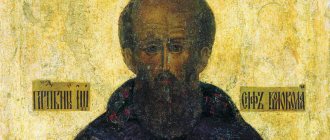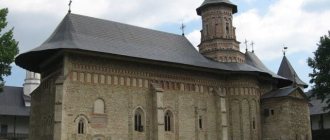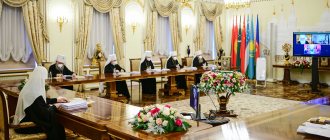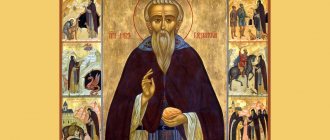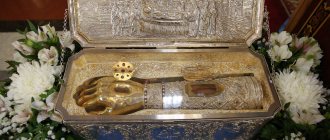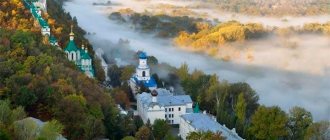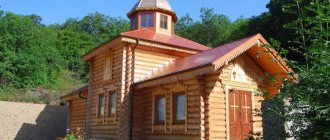Gifted young man
The Monk Joseph of Volotsky was born on November 14, 1439 into the noble family of the Sanins. At holy baptism he was given the name Ivan. The Sanin family was in the service of Prince Boris Volotsky (1449-1494).
Ivan III sends his brothers Andrei and Boris Volotsky to Kazan. Miniature of the Facial Chronicle Code
The Sanins owned the village of Yazvische, located in the specific Volotsk principality. It is known that besides Ivan they had three more sons. As an eight-year-old boy, Ivan Sanin learned to read and write from Elder Arseny at the Volotsk Holy Cross Monastery.
Ivan was distinguished by his abilities and great diligence in church service. He was so gifted that in one year he studied the Psalter, and in the next - the entire Holy Scripture. Everyone was amazed at his extraordinary memory. He could pray the Psalter, the Gospel, the Apostle by heart.
Childhood and adolescence
The life of the saint was described in 1546 by Bishop Savva Cherny of Krutitsky. The worldly name of the saint is John Sanin. He was born in November 1439 or 1440 in the village of Yazvische-Pokrovskoye (near Volokamsk). The father of the future saint was also called John, and his mother was Marina. Subsequently, his parents accepted monasticism, becoming Ioannikios and Maria.
When John was 7 years old, he was sent to study. The boy surprised everyone with his sharp mind and rare memory. As a child, he managed to memorize the Psalter and Holy Scripture.
As John matured, he began to show a sincere interest in asceticism and monastic life. At the age of 20, he came to the Tver Savvin Monastery, where he became a novice of Elder Barsanuphius. After some time, the young man, having received the blessing of his spiritual mentor, went to Borovsk. Here was the monastery of St. Paphnutius of Borovsky, famous for its deep asceticism. Arriving at the monastery, the young Christian became a monk and received the name Joseph.
Monastic path
Around 1459, Ivan, together with his friend Boris Kutuzov, who also came from a noble family, decided to take monastic vows. Subsequently, the father and mother of the monk, all his brothers and three nephews took monastic vows.
Initially, Ivan Sanin went to the Savvin Monastery in Tver. However, the local monastery charter did not seem very strict to Ivan, and soon he moved to the monastery of the city of Borovsk to Paphnutius Borovsky.
Here Ivan was received with love. Finally, his most important wish came true: monastic tonsure with the name Joseph took place on February 13, 1460.
With great zeal, Monk Joseph fulfilled his obediences. He was especially sensitive to visiting the sick: “feeding and drinking the sick, raising and arranging beds, as if he were in pain and working cleanly for everyone, as if he were serving Christ Himself.” The life of the Monk Joseph says that he “in church hymns and readings was as much like a gusset and a glorious good-voiced one, delighting the ears of those who listened, like no one else anywhere.”
Joseph spent about eighteen years in the Borovsky monastery, constantly being in prayer and labor.
In 1477, Paphnutius Borovsky reposed. Before his death, he appointed Joseph as his successor. Soon Joseph was ordained a monk. Appointed abbot of the monastery, he tried to introduce a strict communal charter following the example of the Kiev-Pechersk, Trinity-Sergius and Kirillo-Belozersky monasteries, but faced strong discontent from the monks.
Foundation of the monastery
Then Joseph, together with like-minded monks, went to the Volokolamsk region, where Boris Vasilyevich reigned at that time. The prince received the monk with joy, allowed him to settle within his borders, at the confluence of the Struga and Sestra rivers, and gave people to build a church.
It is known that the choice of a place for the monastery was accompanied by a significant phenomenon: a storm that broke out felled the forest in front of Joseph and other monks, as if providing a place for the future monastery. It was here in June 1479 that devotees erected a cross and founded a wooden church in honor of the Dormition of the Virgin Mary, which was consecrated on August 15, 1479. This was the beginning of the foundation of the Assumption Monastery near Volok Lamsky (currently the city of Volokolamsk, Moscow region).
Joseph-Volokolamsk Monastery
Quite soon a monastery was built. Joseph worked hard to build the monastery. “He was skilled in every human activity: he felled wood, carried logs, chopped and sawed,” says his Life.
The good reputation of the local ascetic attracted disciples to him. The number of monks soon increased to one hundred people. Joseph preached abstinence and moderation in everything. His clothing was simple rags and bast shoes. He came to church first of all the inhabitants, read and sang in the choir along with others, spoke sermons, and was the last to leave the church. At night, Joseph made sure that the monks spent their time in prayer and not in talking. He passed the cells and, if he heard conversations, immediately knocked on the door and left.
Monastery Tower
Joseph paid the main attention to the internal structure of the life of the monks. He introduced the most strict community life according to the charter he drew up, to which all the ministries and obediences of the monks were subordinated and their whole life was governed: “both in walking, and in words, and in deeds.” The basis of the charter was complete non-acquisitiveness, cutting off one’s will and incessant labor.
Ancient frescoes of the Assumption Cathedral of the Joseph-Volotsk monastery
Ancient frescoes of the Assumption Cathedral of the Joseph-Volotsk monastery
The brothers had everything in common: clothes, shoes, food. None of the monks could bring anything into the cell without the blessing of the abbot, not even books and icons. By common agreement, the monks left part of the meal to those in need. All idleness was rejected. Many people in the monastery were engaged in copying liturgical and patristic books. This is how one of the best Russian monastic libraries appeared in the monastery.
Assumption Cathedral of the Joseph-Volotsk Monastery
Every year the Volokolamsk Monastery developed and became beautiful. In 1484–85, a stone Church of the Assumption of the Virgin Mary was built on the site of the previous wooden one. The paintings of the temple were done by Dionysius the Iconologist with his sons Vladimir and Theodosius, as well as by his nephews and students, the monks Dosifei and Vassian Toporkov. In 1504, a warm refectory church was founded in honor of the Epiphany of the Lord, then a bell tower was built and under it the temple of the Most Holy Theotokos Hodegetria.
Joseph-Volokolamsk Monastery
After the revolution of 1917, the monastery was closed; its buildings housed an orphanage, a school, and a cinema hall in the Assumption Cathedral. In 1989, the monastery was returned to the Russian Orthodox Church.
View of the Assumption Cathedral of the Joseph-Volotsk Monastery
It is noteworthy that the buildings of the monastery absorbed elements of Novgorod architecture, and this is not accidental, because it was through Volok Lamsky and the surrounding area that the Novgorodians passed, transporting ships from the Lama River to Voloshnya.
View of the gate church of the Joseph-Volotsk Monastery and the monument to St. Joseph
Ruins of a bell tower with a temple in honor of the Smolensk Mother of God (“Izhe under the bells”). Built in the 1910s of the 16th century. Located on the territory of the Joseph-Volotsk monastery
Troparion, tone 5.
As the fasting man fertilizes, and the father the beauty, the giver of mercy, the wisdom of the lamp, all the faith that has come together, let us praise the meekness of the teacher, and the heresy disgraceful, the wise Joseph, the Russian star. Praying to the Lord, have mercy on our souls.
Kontakion, tone 8.
Lives of unrest, and worldly rebellion, and passionate leaping are imputed to nothing. The deserted citizen showed up. The Reverend Joseph was a mentor to many, a fellow monk, a faithful prayer book, and a guardian of purity. Pray to Christ God to save our souls.
Volotsk abbot
September marks 500 years since the death of St. Joseph of Volotsk. The founder of the monastery near Volokolamsk is one of the most prominent personalities among church leaders of medieval Rus'
Rev. Joseph Volotsky
Joseph Volotsky (in the world Ivan Sanin , 1439–1515) left a deep mark on theology, literature, and icon painting; his ideas had a strong influence on the spiritual culture of Russia. What is the biography of this personality in the light of the data of modern science?
Ivan from the village of Yazvische Ivan Sanin was born on November 12, 1439 in the ancestral patrimony of his father Ivan Grigorievich - the village of Yazvische near the city of Volok Lamsky (now Volokolamsk). The boy was named Ivan in memory of St. John the Merciful . Life in the Volotsk patrimonial family was not easy. In the 1440s–1460s, Rus' was often visited by the plague and was plagued by crop failures and the resulting famine.
Recently, reliable facts have been obtained that speak of the great hardships that the future abbot had to endure in childhood. In 2001, during excavations in the Assumption Cathedral of the Joseph-Volokolamsk Monastery, the honest remains of St. Joseph of Volotsk . The experts’ materials present the following conclusions: “X-rays of the right tibia reveal two zones of growth arrest—Harris lines. Such features indicate the fact of severe illness or stress (hunger, trauma, etc.) that occurred in childhood.” It turns out that Ivan Sanin’s was on the verge of death at least twice in the 1440–1450s. This could have happened in 1442–1443, 1445–1448, and also in 1453.
The disasters he experienced had a great influence on the formation of the character of the monk. Subsequently, the gates of his monastery were never closed to the hungry, the poor and the wretched; caring for food for the needy became one of the main testaments of this great ascetic.
The young man found the brethren, led by the abbot, in the forest at work. When, already at dusk, everyone was returning to the monastery for the evening service, he chose the right moment and threw himself at the feet of the Monk Paphnutius. At seven years old, Ivan was apprenticed to the elder of the Holy Cross Monastery in Volok Lamsky, Arseniy Lezhenka . Studying was surprisingly easy for the boy. In the first year he memorized the entire Psalter. By the age of nine, Ivan Sanin was already performing the duties of a singer and reader in the church. The clergy and parishioners marveled at his extraordinary abilities and predicted a great destiny for him.
Many days spent reading the Divine Scripture and the lives of saints, in church services, inclined Ivan to take monastic vows. There are 18 monastic names in the family of St. Joseph of Volotsk His parents, grandparents and all his brothers ended their lives in holy monasteries. Ivan Sanin was no exception. Elder Barsanuphius Neumoy from the Tver Savvina Monastery advised him to go to Borovsk to the famous abbot Paphnutius ...
In the footsteps of Paphnutius Borovsky
Ivan reached the monastery of Paphnutius in the winter of 1460. The young man found the brethren, led by the abbot, in the forest at work. When, already at dusk, everyone was preparing to return to the monastery for the evening service, he chose the right moment and threw himself at the feet of the Monk Paphnutius.
Venerable Paphnutius Borovsky
St. Pafnutev Borovsky Monastery. Here Ivan Sanin took monastic vows with the name Joseph in 1460
On February 13, 1460, on the feast day of Saint Martinian, Ivan Sanin took monastic vows with the name Joseph . His first obedience was work in the cookery - the most difficult in the monastery. Then Joseph successively passed obedience in the bakery and the monastery hospital. In the Borovsk monastery, Joseph’s seriously ill father took monastic vows; his son took him into his cell and looked after him for 15 years.
Joseph's obvious advantages, which set him apart from the rest of the brethren, were his excellent knowledge of church services and his extraordinary rhetorical and singing abilities. The young monk enjoyed the trust of Paphnutius and carried out important assignments for the abbot.
Before his death, Paphnutius commanded the brethren of the monastery to petition Grand Duke Ivan III so that Joseph would be elected to the post of abbot. In May or June 1477, Joseph Sanin received a reception at the Grand Duke's palace. Ivan III personally talked with him and, apparently, was pleased with the choice of Paphnutius. However, in the coming months, dramatic events occurred in the monastery, prompting the newly installed abbot to leave the monastery.
Firstly, the brethren were excited by his plans to organize monastic life on the basis of strict rules that excluded the ownership of cells and property. Secondly, Joseph Sanin dared to enter into conflict with the Russian autocrat himself, whose officials were ruining the monastic peasants.
Joseph’s requests to keep the monastery’s economy intact in the name of the behests of Abbot Paphnutius not only did not find understanding at the Moscow court, but also caused severe irritation. Seeing no way to improve the situation and not wanting to expose the monastery to danger, Joseph left it no later than August 1477.
The path to your abode
Joseph left the Pafnutiev Monastery, accompanied by Elder Gerasim Cherny . On this journey, he, not wanting to be recognized, played the role of Gerasim's student. Disguised as wandering monks, they visited several monasteries. In each of them, Joseph, pretending to be an illiterate simpleton, performed the most difficult obediences.
Kirillo-Belozersky Monastery. Joseph took its structure as a model when creating his own monastery
For the longest period, Elder Gerasim and Joseph stayed in the Kirillo-Belozersky Monastery. Founded by Kirill Belozersky, Sergius of Radonezh , in 1397 or, more likely, in 1407, by the second half of the 15th century this monastery had become an influential spiritual center. It had a cenobial (communal) structure: the brethren had everything in common - both personal labor and all property belonged to the whole community. Joseph came to the conclusion that the structure of the Kirillo-Belozersky Monastery was the best of everything he had ever seen.
During Joseph’s entire wandering, which lasted from August 1477 to the spring of 1479, the Borovsky monastery remained without beginning. The abbot's return was triumphant, but this did not affect his decision to leave the place of his tonsure forever. In May 1479, together with the elders Gerasim the Black, Cassian Bosy , his brothers Vassian and Akaki Sanin , as well as Cassian the Young and Hilarion , Joseph finally left the monastery of St. Paphnutius .
He decided to found a new monastery on the lands of his family estate. On June 6, in a clearing located on the banks of the Struga River, the wooden Church of the Assumption of the Blessed Virgin Mary was founded. The appanage prince Boris Vasilyevich Volotsky and his boyars took part in the foundation of the temple. Already on August 15, the church was consecrated.
Joseph's first desire was to attract more brethren to the monastery. The rapid growth of the monastery confirmed the high authority of the abbot and made it possible for the appanage prince to feel a sense of pride in his young principality, in which an important spiritual center was being formed, ready in the future to compete with the Trinity-Sergius and Kirillo-Belozersky monasteries in the grand-ducal possessions.
Waiting for the end of the world
The high religious upsurge experienced by the brethren of the Joseph Monastery during the period of its creation was largely explained by the repentant sentiments that began to dominate in the minds of people at the end of the seventh thousand years from the creation of the world.
There was an influential tradition that dated the end of the world to this date (around 1492). Each of the brethren had before his eyes the impending hour of death and awaited the afterlife judgment, at which the fate of the soul was to be decided. In the early years, there was no warm church in the monastery, and many hours of services were performed in the winter, even in the most severe frosts, in a cold church. At the same time, the monks stood at services in their vestments, warmed by the memory of the hellish cold that was in store for sinners.
The fear of the Last Judgment brought people from boyar and noble families to the monastic cells, along with commoners who longed for the salvation of their souls. Having joined the ranks of the brethren of the Joseph Monastery, they became indistinguishable from the rest of the people living in the monastery. The division of monks into elder and younger brethren, which later became common, was also absent, since each member of the community tried to contribute to the development of the monastery. Daily hard work was a severe test: those who were not ready to devote their lives to monastic service left, and their places were taken by those who were not afraid to share all the hardships with the abbot and brethren.
At the end of the seventh thousand years from the creation of the world (about 1492), people expected the end of the world
In June 1484, construction of the white stone Cathedral of the Assumption of the Blessed Virgin Mary began in the monastery. In the summer of 1485, it was painted by a team of craftsmen led by the famous icon painter Dionysius . By May 1506, with donations from Prince Semyon Ivanovich Belsky and the okolnichy Boris Vasilyevich Kutuzov, a warm church in honor of the Epiphany and an adjacent refectory were also erected. During the same period, a stone cookhouse, a bakery, and outbuildings appeared in the monastery.
Christian charity and business calculation
An indispensable condition for the existence of any large monastic community in Rus' was the presence of estates. The first land holdings of the monastery founded by Joseph were the villages of Spirovskaya, Yartsevskaya and Rugotinskaya granted by the Volotsk prince Boris Vasilyevich in October 1479. A little later, in January 1480, he gave the monastery the village of Pokrovskoye, in May 1483 - the village of Otchishchevo, and his wife Princess Ulyana gave the village of Uspenskoye.
The surrounding landowners, the serving corporation of Volok Lamsky, formed the environment in which Ivan Sanin . People from the Beleutov , Zvorykin, Esipov, Karamyshev, Kutuzov-Glebov, Lenkov, Mechov, Mizhuev, Polevy, Rakitin, Rzhevsky, Rostopchin, Stupishin, Tolbuzin, Tyutchev, Prince Khovansky and others families, well-known in Volok, joined the ranks of investors and brethren of the monastery. By the beginning of the 16th century, tonsures appeared in the monastery from among the close associates of the Volotsk prince: boyar children Prince Andrei Golenin, Prince Daniil Lupa of Zvenigorod, Nil Polev, Andrei Nevezha Kvashnin, Boris Oboburov, Pavel Golova Vladimirov, Pyotr Tyutchev, Jonah Golova Cannons . The gates of the monastery of St. Joseph were never closed to the hungry, the poor and the wretched; caring for the food of the needy became one of the main behests of the great ascetic. The monastery's relations with peasants from nearby villages were built with the prospect of long-term cooperation, and this combined the ideals of Christian charity and business calculation. The abbot's willingness to compensate the peasant for the cost of a broken scythe, a stolen horse or a missing cow, in addition to an act of mercy, was also based on the calculation of future economic benefits. Peasants from the estates of surrounding landowners, observing such a picture, wanted to move to the villages of the monastery in order to enjoy all the advantages of a large and rich economy.
Due to rational management of the economy, as well as thanks to the exemption from most taxes and the receipt of monetary and property contributions, the monastery became the owner of significant funds, reserves of grain and other products. This allowed the monastic authorities to provide assistance to the peasants, providing them with grain for sowing, issuing some sums, supplying them with implements and draft animals. During famine, which was not a rare occurrence in that era, the monastery helped those in need, saving them from death. In a message to Princess Golenina , Joseph reported that every day 600–700 people gathered at their meal. And on the main monastery holiday of the Dormition of the Blessed Virgin Mary, more than 1000 beggars were fed there.
A unique feature of the Joseph Monastery was the development of an exemplary system of commemorating the dead, in which the size of the contribution corresponded to the nature of the commemoration. The central role here belonged to the memorial synodics. In the preface to one of these lists Joseph Volotsky indicated that memorial synodics should become the basis for the material well-being of the monastery. In order for people to strive to give contributions to their hearts, they took care of the strict organization of funeral services.
Commemoration of the dead in the main church of the monastery took place at special services on Monday, Wednesday and Friday. In addition, for the first time in the Joseph Monastery, a division between daily commemoration and synodik appeared. The names recorded in daily commemoration were read out by the priest at the proskomedia, at the anaphora during the Divine Liturgy and at requiem services, and the names from the commemoration synod were read out by the clergyman throughout the day, regardless of the services.
In the first quarter of the 16th century, the system of funeral cult developed in the Volotsk monastery (the only mechanism for the redistribution of wealth in medieval society) was borrowed by the largest Russian monasteries.
Heresy of the Judaizers
While the Monk Joseph was busy organizing his monastery within the Volotsk principality, in the huge Novgorod diocese, to which his monastery belonged, events began to develop that had a huge impact on the spiritual culture of Rus'. It was Joseph Volotsky who was to play the most important role in the ideological struggle against the heresy of the Judaizers.
On November 8, 1470, the Lithuanian prince Mikhail Olelkovich . In his retinue there was a certain “Jew Skhariya” . Researchers have broken many copies around the personality of Skhariya. At present, it can be considered established that the famous Kiev Jewish scientist Zechariah ben Aharon ha-Kogen . Taking advantage of his stay in the city, he managed to make acquaintance with prominent representatives of the Novgorod clergy. The starting point for the dialogue was the question of the timing of the end of the world.
Execution of heretics. Miniature from the Facial Chronicle. 16th century
Skhariya's knowledge of astrology, and primarily in alternative calendar systems, seduced the priests Denis and Alexei . It is known that priest Alexey served in the Church of the Archangel Michael on the Torgovaya side. The busy shopping area was then the most convenient place for communication between representatives of different countries and faiths, who came to the city on the Volkhov for one purpose or another. Soon, the rectors and priests of the largest Novgorod churches became members of the heretical circle. Archpriest Gabriel served in the first church of the city - St. Sophia Cathedral; priests Fedor, Vasily, Ivan - in churches on the territory of Detinets. Another influential figure involved in the heresy was the boyar Grigory Tuchin .
In the winter of 1480, after the arrest of Novgorod Archbishop Theophilus , two heretics - priests Alexei and Denis - made rapid careers in Moscow: the first became rector of the main church of the Russian metropolis - the Assumption Cathedral in the Kremlin, and the second - rector of the Archangel Cathedral, the grand ducal tomb.
Novgorod Archbishop Gennady learned about the existence of a circle of heretics in the fall of 1487 quite by accident. Several heretics, while drunk, desecrated the icons. Among those exposed was priest Naum, who repented and gave comprehensive information about his accomplices. Archbishop Gennady ordered the “original” to be drawn up, which included the materials of the investigation, which included the testimony of witnesses, as well as interrogative speeches of heretics. The “notebooks” of priest Naum were also included in this. The Bishop of Novgorod sent one copy of the “original” to the Metropolitan, the other to the Grand Duke. Gennady’s messages did not go unanswered, but Grand Duke Ivan III and Metropolitan Gerontius recognized the validity of only those accusations that were supported by the testimony of other witnesses besides priest Naum. The priests Eresim and Gregory with their son Samsonka were punished in Moscow with “city execution,” that is, they were publicly whipped in the square. And then they were sent to Novgorod to repentance to Vladyka Gennady.
At the end of May 1489, Metropolitan Geronty . In September 1490, the metropolitan throne was occupied by Archimandrite Zosima , whom contemporaries considered to be a protege of Archpriest Alexei . Archbishop Gennady, the only one of the hierarchs who was not present at the council that elected him metropolitan, addressed Zosima in October with a message in which he defended himself from the accusations and put forward a sharp demand for the punishment of the heretics he had exposed, the “Jewish wise men.” Other bishops also initiated their church condemnation and forced the metropolitan to convene a council. At the council on October 17, nine people were condemned. The heretical clergy were defrocked, all were excommunicated and sent to prison.
The verdict of the church council of 1490 and the “Teaching” to “all Orthodox Christianity” by Metropolitan Zosima were sent to all dioceses and large monasteries. Abbot Joseph also became acquainted with these materials. Two years earlier, he had already received information about the condemnation of Novgorod heretics by Archbishop Gennady. The Monk Joseph could not remain indifferent to heretical attacks on the truths of faith.
Palace intrigue
The Council of 1490 did not put an end to the heresy of the Judaizers. The clerks Fyodor and Ivan Volk Kuritsyn (the first of them was directly accused by the Novgorod ruler Gennady of patronizing heresy) not only retained, but also strengthened their position at court and enjoyed great influence on the Grand Duke. After Zosima took the metropolitan throne, the position of Moscow heretics strengthened significantly. The Kuritsyn clerks ensured that their protege Cassian .
Joseph Volotsky created his treatise in defense of the Orthodox faith in the silence of a monastic cell. Due to external unfavorable circumstances, he compared his work to the writings of Antiochus from the Lavra of Sava the Sanctified, composed during the period of the Persian invasion, and Nikon the Montenegrin, who created his treatises during the invasion of the Turks. If it was permissible to expose the views of Denis, who was officially condemned as a heretic and deprived of his priestly rank, it was dangerous to argue with the opinions expressed by the clerk Fyodor Kuritsyn , who was close to the Grand Duke.
The zealots of Orthodoxy could only hope for changes for the better at the Moscow court. It can be assumed that they pinned their hopes on Grand Duchess Sophia Paleologus and her eldest son, Prince Vasily . Their opponents united around the son from his first marriage and co-ruler of Ivan III, Ivan Ivanovich the Young and his wife Elena Stefanovna .
In the spring of 1490, Ivan the Young suddenly fell ill and died. The heirs of Ivan III, who crossed the 50-year mark, turned out to be his 7-year-old grandson Dmitry Ivanovich and his 11-year-old son from Sophia Paleolog Vasily . The threat to their succession to the throne was posed by the brothers of the first sovereign of all Russia - appanage princes Andrei Uglitsky and Boris Volotsky . In 1492, Prince Andrei was summoned to Moscow, where on September 20, by order of the Grand Duke, he was captured and imprisoned.
The chronicles are modestly silent about the role of Metropolitan Zosima in this story. Meanwhile, the appanage prince would never have come to Moscow without guarantees of his safety from the metropolitan. Andrei Uglitsky was starved to death in prison: he died on November 6, 1493. His death left a black mark on the conscience of Ivan III and the reputation of Zosima, but the grandson and son of the Grand Duke were spared from attempts on power by the appanage princes. On May 17, 1494, Zosima left the metropolitan throne. It’s hard not to remember the saying “The Moor has done his job, the Moor can go.”
On February 4, 1498, the official coronation of Dmitry Ivanovich : “Monomakhov’s barmas and cap” were placed on him. But a year later, Ivan III named Prince Vasily “Sovereign Grand Duke” and gave him Veliky Novgorod and Pskov “for a great reign.” The situation of uncertainty regarding the issue of succession to the throne and the precarious balance between the Grand Dukes Dmitry and Vasily remained at court until the spring of 1502. In April 1502, Dmitry Ivanovich and his mother Elena Stefanovna were sent to prison, and Vasily became the sole heir of the sovereign of all Rus'.
Dispute with non-possessors
At the end of July 1503, all the ruling bishops of the Russian Metropolis, archimandrites and abbots of the largest monasteries came to Moscow. The purpose of convening the council was to discuss issues of church discipline. Nil Sorsky unexpectedly gave a speech . He called on the fathers of the council to prohibit monasteries from owning villages, since this violates the commandments of non-covetousness. The call of the Nile was supported by his like-minded people, the Belozersk hermits. Everyone understood that behind the modest robes of the ascetic elders was hidden the figure of the all-powerful Grand Duke.
Neither the new Metropolitan Simon nor other bishops dared to object to the Belozersk hermits. Only Abbot Joseph from the Volotsk principality raised his voice in defense of the monastic landholdings. He pointed out that the custom of owning villages appeared simultaneously with the emergence of monasticism. He recalled that in Russia the villages were owned by the Kiev-Pechersk Monastery, glorified by the names of the wonderworkers Anthony and Theodosius . And he warned that the impoverishment of monasteries would inevitably lead to a weakening of the church hierarchy and the destruction of the Christian faith.
The abbot of the Trinity-Sergius Monastery, Serapion, spoke in support of Joseph Volotsky. As a result, the fathers of the cathedral categorically rejected the proposals of Nil Sorsky and the Belozersk hermits. But Ivan III was not satisfied with the course of church meetings. He was preparing a grandiose revision of the property rights of the largest monasteries.
The outcome of the confrontation was decided by chance: on July 28, 1503, the Grand Duke suffered a stroke, half of his body was paralyzed (“he lost an arm and a leg and an eye”). Then the issue of monastic and sovereign lands disappeared from the agenda as suddenly as it had appeared. Both secular and spiritual authorities tried to forget about the incident, which cast a shadow on the reputation of Ivan III as a pious ruler. For this reason, only the verdicts of the council of 1503 devoted to disciplinary issues were reflected in the official chronicle.
Fight against heretics
In the period between April 1502 and December 1504, at the court of the Grand Duke, in the monasteries of Moscow and Novgorod, and even in the Trans-Volga hermitages and deserts, the pressing issue of the fate of the heretical Judaizers was discussed. By 1502, the “Book on Heretics,” written by Joseph Volotsky to refute the views of the Judaizers, became famous. This treatise consistently and in detail analyzed the beliefs of those who gained fame as the first intellectuals at the Moscow court - the rectors of the main churches of the Kremlin, Archpriest Alexei and Priest Denis, as well as the Grand Duke's clerk Fyodor Kuritsyn.
“The Book on Heretics” was written by Joseph Volotsky to expose the views of Judaizers
The Moscow autocrat suddenly discovered affection for Abbot Joseph. Between April 1502 and May 1503, the Grand Duke had three meetings with him. The Sovereign of All Rus' sought to obtain the forgiveness of Joseph of Volotsky, citing the fact that the Metropolitan and the rulers had already forgiven him. The abbot demanded effective measures to find and punish exposed heretics. Probably, at the request of Joseph, Ivan III in 1502 appointed his brother, Vassian Sanin, archimandrite of the Moscow Simonov Monastery.
While conducting an investigation into the activities of the Judaizers, Vassian quite unexpectedly received at his disposal facts indicating the adherence to the heresy of the former Metropolitan Zosimas. By that time, Zosima was already living in retirement in the Trinity-Sergius Monastery, where he enjoyed honor and respect and retained most of his influence on the rulers and clergy. When it became known about the evidence exposing Zosima to heresy, Joseph Volotsky urgently supplemented his treatise with the “Tale of the Newly Appeared Heresy.” And if the words (chapters) of the main part of the “Book on Heretics” were written with the aim of exposing the views of Archpriest Alexei, Priest Denis and clerk Fyodor Kuritsyn, then in the “Tale” Metropolitan Zosima appears as the main enemy of Orthodoxy.
Soon after completing work on the 12th, 13th and 14th words of the “Book on Heretics,” Joseph began sending messages to the most influential hierarchs, urging them to begin the fight against high-ranking heretics. Investigative research into the case of the Judaizers was reopened no later than the spring-summer of 1504, and by December the main base of accusations had been formed.
The church council took place in December 1504. Soon executions of heretics took place in Moscow and Novgorod. Belozersk hermits protested against the executions of repentant Judaizers. The polemical confrontation between the non-possessors and the Josephites, which opened in 1503 with a dispute over the monastic villages, continued with a debate about the fate of the heretics.
Confrontation with the monk prince
The monastery of St. Joseph arose and developed with the active assistance of the Volotsk appanage princes. However, Fyodor Borisovich Volotsky, after the death of his father, mother and younger brother, completely changed his attitude towards the monastery. He began to take away money and property brought by investors from the monastery, threatening the brethren with reprisals. Wanting to protect the monastery from violence, in February 1507 Joseph turned to Grand Duke Vasily (Ivan III died in 1505) with a request to take the monastery under his protection.
Joseph-Volokolamsky Monastery was founded in 1479
Vasily III, in agreement with Metropolitan Simon , fulfilled the request of the abbot, but at the same time the monastery remained under the jurisdiction of the Novgorod diocese and had to continue to pay taxes from its lands to the Volotsk prince. The latter managed to bribe people from the circle of the new Novgorod Archbishop Serapion and achieved the excommunication of Joseph Volotsky from the church. There was nothing left but to once again resort to the intercession of the Metropolitan and the Grand Duke. The abbot of the Volotsk monastery was completely acquitted at the council of 1509, and Archbishop Serapion was defrocked as having imposed punishment contrary to church canons. It would seem that fate once again favored Joseph, but she sent him another difficult test.
In 1509, the prince-monk Vassian Patrikeev , who spent 10 years in the Kirillo-Belozersky Monastery, closely communicating with non-covetous people from among the opponents of the Volotsk abbot. He managed to win the trust of his second cousin Vasily III and issued a number of messages against Joseph, in which he denounced the abbot for his addiction to monastic acquisitions, blamed him for the persecution of heretics, etc.
The dispute was not equal: Vassian Patrikeev was the recognized favorite of Vasily III (“the great temporary man”), and Joseph was forbidden to write in his own defense. The situation changed only in the last year of the life of the founder of the monastery near Volok Lamsky. In 1515, Vasily III visited the monastery and gave it new land.
Around 1507, Joseph Volotsky was seriously ill. He reposed “on the 9th day of September at 10 o’clock at night, in memory of the saints and righteous Godfathers Joachim and Anna, from Saturday for the week, on the 8th hymn of the morning.” The brethren of the monastery mourned their abbot, bitterly regretting the loss. According to Dositheus Toporkov , Joseph’s nephew and hagiographer, the Volotsk abbot embodied the unfeigned love for Christ and the virtues of the Old Testament patriarchs: the love of Abraham, the kindness of Jacob, the chastity of Joseph, the patience of Job, the mercy of Moses, the meekness of King David.
In the monastery, soon after his death, Abbot Joseph began to be venerated with the rank of saint, but church-wide canonization took place only in 1591. These were the consequences of Joseph’s participation in the socio-political struggle, over the years of which he acquired many influential and strong opponents. Disputes about his personality and creative heritage continue to this day - both among specialists and among representatives of the general public.
Author: Alexey Alekseev , Doctor of Historical Sciences
WHAT TO READ?
Alekseev A.I. Joseph Volotsky. M., 2014 (series “ZhZL”)
GRAND DUKAL DECEAK
Fyodor Vasilyevich Kuritsyn, a native of a boyar family, an influential diplomat, a famous writer, was one of the most trusted associates and advisers of Ivan III. Many achievements and undertakings of that era are associated with the efforts of this efficient clerk. Joseph Volotsky complained that the Grand Duke had become dependent on Kuritsyn. “The sovereign listened to him in everything,” wrote the abbot. Fyodor Kuritsyn was a supporter of strong princely power. From a long trip through Hungary and Wallachia, Kuritsyn returned not only with an agreement on “brotherhood and love” that was beneficial for Moscow, but also with new ideas, largely in opposition to the foundations of the church. The clerk criticized monasticism and talked about the broadly understood freedom of the will of man (“autocracy of the soul”). He headed the Moscow heretical circle - there he preached his ideas. In the confrontation between the Moscow boyars and the courtiers, Fyodor Kuritsyn supported Dmitry Ivanovich, the grandson of the Grand Duke, the son of the early deceased Ivan the Young. The active struggle of Joseph Volotsky against heretics determined the collapse of the court party of Dmitry Ivanovich. After 1500, Kuritsyn was removed from power. In 1504, his brother Ivan Volk, another representative of the political elite of that time, was executed. The fate of Fyodor Kuritsyn himself is mysterious: most likely, he was not executed, but died in disgrace.
QUESTION ABOUT MONASTERY DOMAINS. NILE OF SORA AND JOSEPH OF VOLOTSKY
“Monastic land ownership was a doubly careless sacrifice made by a pious society to the insufficiently clearly understood idea of monasticism: it interfered with the moral well-being of the monasteries themselves and at the same time upset the balance of economic forces of the state. Earlier, his internal moral danger was felt. Already in the 14th century, Strigolniks rebelled against contributions according to their souls and all kinds of offerings to churches and monasteries for the dead. But they were heretics. Soon the head of the Russian hierarchy himself expressed doubts whether it was appropriate for monasteries to own villages. One abbot asked Metropolitan Cyprian what he should do with the village that the prince had given to his monastery. “The Holy Fathers,” answered the Metropolitan, “did not give over to monks to rule over people and villages; When the Chernetsy own the villages and undertake worldly cares, how will they differ from the laity?” But Cyprian stops short of a direct conclusion from his provisions and makes a deal: he offers to accept the village, but to manage it not to a monk, but to a layman who would bring everything ready-made, livestock and other supplies from there to the monastery. And the Monk Kirill of Belozersky was against the ownership of villages and rejected the proposed land contributions, but was forced to yield to the insistence of the investors and the murmur of the brethren, and the monastery already under him began to acquire estates. <…>The Nile and the Belozersk hermits who stood for it spoke about the true meaning and purpose of monasticism; Joseph referred to examples from the history of the Eastern and Russian churches and at the same time expressed the following series of practical considerations: “If there are no villages near the monasteries, then how can an honest and noble man take haircut, and if there are no noble elders, where can we get people for the metropolitanate, for archbishops? , bishops and other church positions of power? So, if there are no honest and noble elders, then faith will be shaken.” This syllogism was first expressed during a discussion of a practical church issue. Church authorities did not set monasteries the task of being nurseries and breeding grounds for the highest church hierarchs and did not recognize the hierarchy of noble birth as an indispensable stronghold of faith, as was the case in Poland.”
From the “Course of Russian History” by V.O. Klyuchevsky
Literary activity of Joseph Volotsky
Joseph Volotsky is known as a talented church writer. He is the author of the book “The Enlightener” and several messages in which, discussing with another ascetic, the spiritual leader of the “non-possessors” Nil Sorsky , he proved the legality of monastic land ownership and defended the need to decorate churches with beautiful paintings.
Venerable Nil of Sorsky. Drawing (translation from the icon). XVI century. timing belt
Joseph denounced the heresy of the Judaizers, which originated in Veliky Novgorod in 1471 from the Jew Zechariah. Gradually, the heresy reached Moscow, where it spread among common people and even the nobility.
Joseph Volotsky in his book “The Enlightener” (word thirteen) called on the secular authorities to persecute and execute apostates from Orthodoxy and those heretics who seduce the Orthodox with heretical teachings.
The Trans-Volga elders objected to Joseph Volotsky: “unrepentant and disobedient heretics are ordered to be kept in prison, but God’s church accepts the heretics who have repented and cursed their error into open arms.” At the same time, they referred to the commandment “Do not judge, lest you be judged.”
Followers of Patriarch Nikon used the words of St. Joseph to justify the persecution of Old Believers. However, among the Old Believers, calls to kill heretics for the most part met and are met with rejection. The Old Believer Bishop Innokenty (Usov, 1870-1942) wrote that the Old Believer Church will never agree with the doctrine of the execution of heretics, and considers it impossible to kill people for their views.
Temples of the saint and prayers to him
On the territory of Russia there are many churches and cathedrals erected in honor of the great ascetic. They are located in the following places:
- in Moscow, in the Khamovniki and Obruchevsky districts;
- in the cities of Zubtsov and Ostashkov, Tver region;
- in the villages of Razvilka and Teryaevo, Moscow region.
Orthodox people pray to the monk for the conversion of non-believers and strengthening of their own faith, for protection from visible and invisible enemies, for successful work. The saint helps with various diseases and relieves many difficulties. Here you can find an akathist and prayers to Joseph Volotsky.
The Prayer Book is considered the heavenly patron of “Orthodox entrepreneurship and management.” That is why prayers are read to him for successful trade and business prosperity.
